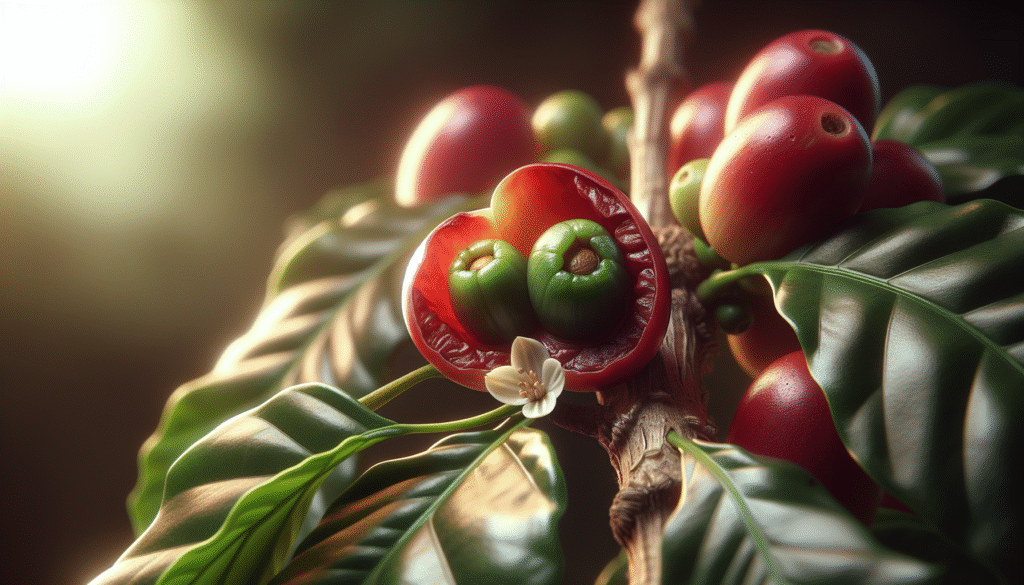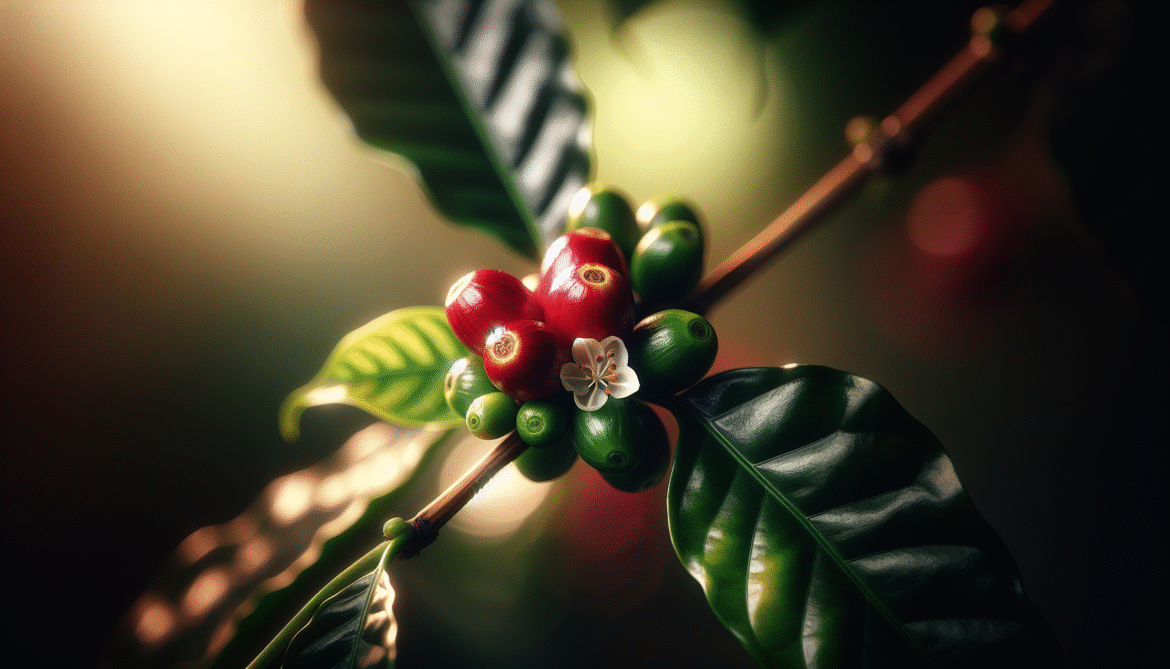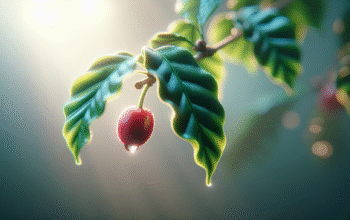Have you ever wondered where the coffee beans in your cup actually begin their life and how they grow on the coffee plant?

How do coffee beans grow on the coffee plant
You’ll find that coffee beans are not beans at all in the botanical sense, but seeds that develop inside the fruit of the Coffea plant. This article walks you through the plant’s biology, farming practices, harvest methods, and how each stage influences the cup you brew.
Overview of the coffee plant and beans
The coffee plant is a small tree or shrub that produces glossy leaves, fragrant white flowers, and oval fruits commonly called cherries. Inside those cherries are typically two seeds (the “beans”) that will become green coffee beans after processing and then transform when roasted.
Coffee species and differences
Most of the coffee grown globally belongs to a few main species, and the species you encounter influence growth habit, flavor, and cultivation needs. Knowing these differences helps you understand why beans look and taste different depending on origin.
| Characteristic | Coffea arabica (Arabica) | Coffea canephora (Robusta) |
|---|---|---|
| Common name | Arabica | Robusta |
| Flavor profile | Generally sweeter, more complex, higher acidity | Stronger, harsher, more bitter, more body |
| Altitude preference | 600–2,200 m (often higher) | Low to medium altitude |
| Caffeine content | Lower | Higher |
| Yield and hardiness | Lower yield, more sensitive to pests and climate | Higher yield, more disease resistant |
| Bean shape | Oval with curved crease | Rounder with straight crease |
You’ll notice species differences affect how and where plants are grown, as well as how long beans take to mature and how they respond to stressors like drought or disease.
Anatomy of the coffee plant
When you look closely at a coffee tree, you’ll see branches with nodes bearing leaves, clusters of flowers, and eventually cherries. Each cherry contains the seeds you recognize as coffee beans, and a series of layers protect and feed those seeds as they develop.
The main parts relevant to bean growth are the stem and branches (support), leaves (photosynthesis), flowers (reproduction), fruit or cherry (seed protection), and the seeds themselves (the harvested commodity).
Life cycle timeline of a coffee plant
Coffee plants pass through predictable developmental stages, but timing varies by species, climate, and management. You’ll get a clearer sense of timing by checking a typical timeline from seed to first harvest and through annual crop cycles.
| Stage | Typical duration or timing |
|---|---|
| Seed germination | 2–4 weeks (in nursery conditions) |
| Seedling to transplantable plant | 6–12 months |
| Flowering onset | 2–3 years for arabica, 18 months–2 years for some robusta varieties |
| Fruit development (flower to ripe cherry) | 6–11 months (varies by species and altitude) |
| Productive life | 10–30 years depending on maintenance |
You’ll see that patience is essential: some plants take years before delivering their first commercial harvest, and seasonal cycles shape the timing of flowers and fruit.
From flower to bean: the biological process
Understanding how beans form requires looking at flowering, pollination, and seed development inside the fruit. Each of these stages is sensitive to environment and management, which affects yield and bean quality.
Flowering and pollination
Coffee flowers are small, white, and fragrant, often compared to jasmine in scent, and they usually appear in clusters along branch nodes. Flowering can be triggered by a change in rainfall or temperature, and the timing determines when cherries will later ripen.
Pollination is mainly assisted by insects like bees and sometimes by wind or self-pollination, depending on the species. If flowers are effectively pollinated, they will develop into cherries that protect and nourish the seeds.
Fruit formation: the green cherry
After successful pollination, the flower’s ovary begins to swell into a green fruit called a cherry. At first the cherry is small and hard, and it gradually enlarges as sugars and water accumulate.
You’ll notice that cherries develop in waves along the branches; not every flower turns into a fruit, and fruit set varies with weather and plant health. The green cherry stage may last several months before color change begins.
Seed development inside the cherry
Inside the maturing cherry, the seed pair forms, usually oriented flat against each other and cushioned by mucilage and parchment layers. Each seed is protected by an outer skin (exocarp), a pulpy mucilage (mesocarp), a parchment-like endocarp, and a silverskin directly on the seed.
The developing seeds store carbohydrates and lipids that later roast into aroma and flavor compounds. Seed development is a complex physiological process regulated by the plant’s nutrient status and environmental cues.
Maturation and ripening
The ripening stage is when cherries change color—from green to yellow, and often to red, though some varieties turn orange or yellow when ripe. Ripening concentrates sugars and softens the pulp, signaling optimal harvest time for quality-focused farms.
You’ll want to pick cherries at peak ripeness to maximize flavor potential. Underripe or overripe cherries will contribute off-flavors and lower cup quality, so timing is critical.
Growing conditions that affect bean development
The environment plays a huge role in how coffee beans develop, influencing size, composition, and taste. As you learn about growing conditions, you’ll see why origin, altitude, and microclimate matter to both farmers and drinkers.
Climate and altitude
Coffee thrives in tropical and subtropical climates where temperature, rainfall, and seasonality are balanced. Higher altitudes generally mean cooler temperatures and slower maturation, which often leads to more complex flavor development.
You’ll find that arabica especially benefits from cooler nights and warm days found at higher elevations, while robusta tolerates hotter, more humid lowlands where it matures faster and yields more.
Soil and nutrients
Soil type and fertility strongly affect root health and the plant’s ability to form healthy cherries and seeds. Coffee prefers well-draining, slightly acidic soils rich in organic matter and minerals like potassium, phosphorus, and calcium.
You’ll notice deficiencies in soil reflected in smaller cherries, fewer beans, or pest susceptibility, so balanced soil management and foliar nutrition are essential for consistent development.
Light and shade management
Light intensity affects photosynthesis and therefore the plant’s energy available for fruit development. Many growers use partial shade to moderate temperatures, improve humidity retention, and protect cherries from intense sunlight.
You’ll find shade can increase cup quality by slowing cherry maturation and allowing more even development of sugars and acids, but too much shade reduces yield and can invite disease.
Water and irrigation
Regular and well-timed water availability is essential during flowering and fruit set. Drought or irregular rainfall can cause flower drop, poor fruit set, or uneven ripening, while excess moisture can encourage fungal diseases.
You’ll want consistent soil moisture without waterlogging; in many producing regions, seasonal rains trigger flowering, and growers may supplement with irrigation during dry periods to stabilize production.
Temperature and seasonal effects
Coffee is sensitive to extremes: frost, prolonged heat, or sudden cold snaps can damage leaves, flowers, or cherries. Seasonality affects when flowering occurs and therefore when cherries will be harvested.
You’ll find that stable, moderate temperatures yield predictable flowering and fruiting cycles, whereas climate variability can shorten or extend the time cherries take to ripen and affect bean composition.

Cultivation and farm practices
How you manage plants will influence plant health, yield, and bean quality. Practical decisions—from propagation to pruning—shape a coffee farm’s productivity and the characteristics of the beans it produces.
Propagation and nurseries
Coffee is often grown from seedlings raised in nurseries, where seeds are germinated in controlled conditions until they form sturdy young plants. Some farms also use vegetative propagation (cuttings or grafting) for clonal uniformity and disease resistance.
You’ll see seedlings kept in shade and well-watered until they’re large enough to transplant into the field, usually after 6–12 months depending on the system and local conditions.
Planting and spacing
Spacing decisions influence light penetration, airflow, and competition for nutrients and water. Standard spacings vary widely, with denser plantings increasing yield per area but requiring more careful management.
You’ll find spacing often ranges from 1–3 meters between trees depending on variety, target yield, and whether intercropping or mechanization is used.
Pruning and training
Regular pruning keeps coffee trees at a manageable height, encourages new productive branches, and controls canopy density. Training and pruning also help reduce disease pressure and make harvesting easier.
You’ll notice that many farms use annual or biannual pruning cycles to stimulate vigorous growth and replace unproductive wood, which sustains yield over the plant’s productive life.
Shade, intercropping, and biodiversity
Integrating shade trees and companion crops provides ecological benefits such as improved soil fertility, pest control, and income diversification. Shade systems can be tailored to maximize biodiversity while maintaining coffee quality.
You’ll see farms that interplant fruit trees or timber species gain additional revenue streams and ecological resilience, and such systems often produce more stable yields over time.
Pest and disease management
Common issues like coffee leaf rust (Hemileia vastatrix), berry borer, and nematodes threaten production and require an integrated approach combining resistant varieties, good cultural practices, and appropriate chemical or biological controls. Monitoring and early response are crucial.
You’ll reduce risk by maintaining plant vigor, ensuring good airflow, practicing sanitation, and using resistant cultivars where available.
Harvesting: when and how beans are picked
Harvest methods and timing greatly influence bean quality. You’ll often find a contrast between methods aimed at maximizing quality and those that maximize speed or yield.
Selective hand-picking
Selective hand-picking means harvesting only ripe cherries, often repeated multiple times during the harvest season. It’s labor-intensive but yields the highest quality because cherries are uniform in ripeness.
You’ll appreciate that specialty coffee producers favor this method, as it preserves the best flavor precursors in each bean.
Strip harvesting
Strip harvesting removes all cherries in a pass, either by hand or machine, and is faster and cheaper than selective picking. This method mixes ripe and unripe cherries together and often suits large-scale production for lower-priced markets.
You’ll find strip-harvested coffee easier to process quickly but typically lower in consistency and cup clarity than selectively harvested lots.
Mechanical harvesting
In flatter regions with suitable varieties and farm layouts, machines can harvest coffee quickly and cheaply. Mechanical harvesters reduce labor needs but usually cannot distinguish ripeness and can damage plants if not used carefully.
You’ll often see mechanical harvesting in robusta plantations or large arabica farms in some producing countries where terrain and economics favor mechanization.
Post-harvest processing and how it impacts the bean
What you do to cherries immediately after harvest determines the seed’s moisture, cleanliness, and how much fruity or fermented character the bean develops. Processing methods are central to flavor and stability.
Washed (wet) processing
Washed processing removes pulp and mucilage shortly after harvest using water and fermentation tanks for mucilage breakdown, then washes and dries the beans. This method tends to highlight acidity, clarity, and brightness in the cup.
You’ll notice washed coffees often taste cleaner and more floral or citrusy, as the processing minimizes the fruit sugars’ direct influence on flavor.
Natural (dry) processing
In natural processing, whole cherries are dried intact, allowing sugars and fermentation to act on the beans for an extended time. This method often produces fruit-forward, heavier-bodied flavors and can be riskier because of potential for unwanted fermentation.
You’ll encounter many natural-processed coffees with intense fruity or wine-like notes, but they require careful drying control to avoid defects.
Honey and pulped natural processing
Honey processing removes the skin but leaves some or all of the mucilage on the seeds during drying. The degree of mucilage left ranges from white (minimal) to black (heavy), and flavor outcomes blend characteristics of washed and natural coffees.
You’ll find that honey process tends to yield sweeter, fuller-bodied cups with more complexity than fully washed methods while avoiding some of the fermentation risks of natural processing.
| Processing method | Short description | Typical flavor impact |
|---|---|---|
| Washed (wet) | Pulp removed, mucilage fermented & washed away | Cleaner, brighter, more acidic |
| Natural (dry) | Whole cherries dried intact | Fruity, full-bodied, wine-like |
| Honey (pulped natural) | Pulp removed, varying mucilage left on seed to dry | Sweet, rounded, balanced between washed & natural |
| Semi-washed / Wet-hulled | Common in some regions (e.g., Indonesia); partial drying & hulling | Earthy, heavy body, reduced acidity |
You’ll realize that processing is as important as growing conditions for final cup quality, and that processors make deliberate choices to shape flavor.
Drying and moisture reduction
After processing, beans must be dried to a stable moisture level (typically around 10–12% for green coffee) to prevent mold and ensure storage stability. Drying can be done on patios, raised beds, or mechanical dryers.
You’ll find that uniform drying and protection from rain and pests are essential, and improper drying is a common source of defects like moldy or fermented flavors.
Hulling, sorting, and storage
Once dried, beans are hulled to remove parchment (in washed coffees) or dried fruit layers (in natural coffees), then sorted by size, density, or defects. Proper storage in dry, ventilated conditions preserves bean quality until milling and roasting.
You’ll encounter various quality controls at this stage, such as hand or machine sorting, flotation, and mechanical gravity tables used to separate defective beans.
Milling and green bean handling
Milling reduces moisture variability, polishes beans if desired, and prepares them for export as green coffee. Green beans are sensitive to moisture, temperature, and odor contamination, so careful handling matters for flavor preservation.
You’ll want to store green beans away from strong odors and humidity, and many roasters buy freshly processed beans and roast them within weeks to months for optimal freshness.
From green bean to cup: how growth affects flavor
Every stage of the coffee plant’s life and every management decision influence the chemical composition of the seeds and therefore the cup. You can relate cultivation and processing practices to sensory characteristics.
Species, altitude, and terroir impacts
Higher altitudes typically yield slower seed development with higher acidity and more nuanced flavors, while soils and climate impart terroir—subtle, location-specific taste notes. Species also supply broad flavor templates: arabica often gives nuanced sweetness and acidity, robusta more body and bitterness.
You’ll detect terroir as floral, fruity, or earthy characteristics tied to region, and you’ll notice similar varieties grown at different altitudes will taste distinct.
Processing and roasting interactions
Processing choices determine initial sugar and fermentation profiles in the green bean, and roasting extracts or alters those compounds into volatile aromatics. Roasters tailor profiles to highlight or smooth certain attributes influenced by growth and processing.
You’ll experience the combined outcome of farm practices and post-harvest choices once the beans are roasted and brewed, making the coffee trade an intricate chain from plant to cup.
Sustainability, economics, and social aspects
Coffee farming is influenced by market demands, climate change, and social conditions. Decisions you support as a buyer can affect farmer livelihoods and environmental outcomes.
Economic pressures and farming livelihoods
Coffee prices fluctuate globally, and many smallholder farmers live with tight margins that affect investments in inputs, disease control, and quality improvements. Stable, fair pricing helps farmers adopt practices that improve both yield and quality.
You’ll find that certifications and direct trade relationships can help ensure fair returns and enable long-term improvements on farms.
Climate change and adaptation
Rising temperatures, altered rainfall patterns, and new pest pressures challenge traditional coffee-growing zones. Farmers adapt by shifting altitudes, changing varieties, and improving shade and water management.
You’ll notice that cultivar research and agroforestry practices are critical to maintaining coffee supply and protecting ecosystems.
Social and ecological certifications
Programs like organic, Rainforest Alliance, and others promote environmental and social standards, but their effectiveness depends on local implementation and market incentives. Certifications can support better practices, though they are not a panacea.
You’ll benefit from understanding what certifications mean and how they translate into farm-level benefits when you make purchasing decisions.
Common myths and frequently asked questions
Myths about how coffee beans grow and what affects cup quality circulate widely. Below are clear answers to common questions you might have.
Q: Are coffee beans true beans? A: Botanically, coffee beans are seeds inside the coffee cherry, not legumes. They’re seeds of the Coffea fruit and behave like seeds from other fruit in germination and development.
Q: Do all cherries contain two beans? A: Most cherries contain two seeds arranged flat against each other, but occasionally cherries contain a single “peaberry,” a single round seed that sometimes has different roasting behavior and flavor. You’ll see peaberries separated and marketed specially in some coffees.
Q: Why do some coffees taste fruity? A: Fruitiness often comes from varietal genetics, altitude, and especially processing methods that retain or enhance fruit sugars and fermentation compounds. Natural processing and selective fermentation can accentuate fruit-forward notes.
Q: How long does it take from flower to ripe cherry? A: Typically 6–11 months, depending on species, altitude, and climate. Higher altitude usually lengthens development time and can enhance complexity.
Q: Can coffee be grown outside the tropics? A: Coffee requires specific temperature and humidity ranges, so commercial production is mostly limited to tropical and some subtropical regions. Some enthusiasts grow coffee as houseplants or in greenhouses where conditions are controlled.
Q: Does shade make coffee taste better? A: Shade often slows ripening and improves microclimate, which can enhance flavor complexity and preserve biodiversity, but outcomes depend on species and how shade is managed. Too much shade can reduce yield and increase disease risk.
Q: Are all red cherries ripe? A: Red is the common indicator of ripeness for many varieties, but some varieties ripen to yellow or orange. You’ll learn to identify ripe cherries by species and local cues rather than color alone.
What you can observe at home or on a farm visit
If you visit a coffee farm or grow a plant at home, watch the flowering period and subsequent fruit set to appreciate the time and conditions required for bean formation. Observing harvest and processing gives insight into how those choices shape flavor.
You’ll find that noticing the tree’s flowers, fruit color, and processing areas connects you more directly to the cup you enjoy and the people who grow and handle the beans.
Summary: how the growing process shapes what you drink
Coffee beans are seeds formed inside a fleshy fruit after flowering and pollination, and their development is shaped by species, altitude, climate, soil, and farm practices. From nursery to harvest and across processing methods, every step contributes chemical and sensory traits that ultimately determine aroma, acidity, body, and flavor.
You’ll appreciate the complexity behind every cup by understanding the plant’s biology and the care taken at each stage. When you sip coffee next time, you’ll be tasting the outcome of months of growth, countless decisions, and a chain of human and natural interactions that began in a tiny flower on a coffee tree.



